What to be on the lookout for…
Phytophthora
Phytophthora (Phytophthora capisci) has become one of the more common diseases in solanaceous and cucurbit crops. It has been most prevalent among pumpkins and winter squash this year. Phytophthora is long-lived in the soil and driven by moisture.
- The disease can infect all parts of the plant tissue. The most apparent symptom is wilting and white, powdered sugar-like spores on infected plant tissue. It can also cause crown, root, and fruit rot.
- It requires 24 to 48 hours of soil saturation to start the disease cycle. Water management is crucial to prevent the disease cycle from starting.
- Break beds into smaller sections to allow water to leave field through lowest paths.
- Avoid bringing Phytophthora-contaminated soil into clean or fumigated fields by means of farm equipment and by working in clean fields first and cleaning equipment after working in contaminated fields.
- Do not throw rotting host crops purchased from off-farm fields into compost piles to be used on clean fields.
- Alternate between two or more soil-applied fungicides, beginning at planting and continuing throughout the season. This has been shown to be more effective than foliar applications. Several products are labeled for drench or trickle applications. See label rates and directions.
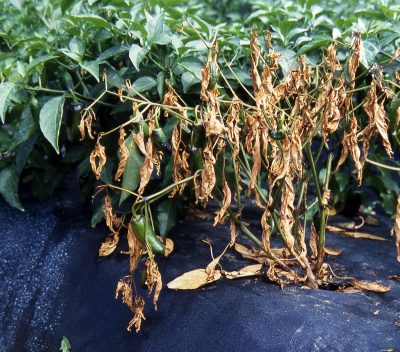

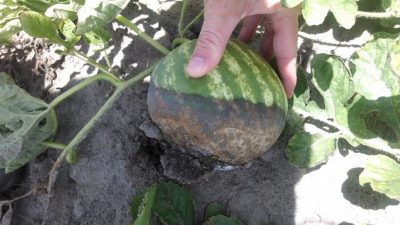
Cucurbit Powdery Mildew
Cucurbit powdery mildew (PM) is a fungal disease that typically develops around mid-summer every year. Now that we are a little past the halfway point, it is becoming and more evident in our field walks. PM leads to extensive defoliation increasing the likelihood of sunscald on fruit and will weaken stems on pumpkins and winter squash. Early intervention is very important.
Scout fields regularly and apply fungicides early in disease development. Protective fungicides (e.g. sulfur, horticultural oils, chlorothalonil, copper, mancozeb) should be applied before the first sign of disease as powdery mildew spreads rapidly and cannot be controlled once it is well established.
See the New England Vegetable Management Guide for currently labeled fungicide options.
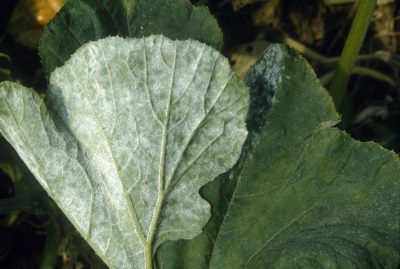
Blossom End Rot on Tomatoes and Peppers
Blossom end rot is a very familiar abiotic disorder for many growers. It is commonly identified on peppers and tomatoes, but can affect squash too. Stressful growing conditions, especially dry spells, are to blame. In peppers, blossom end rot can be confused with sunscald. Water management aimed at keeping the soil moisture consistent is the best strategy to reduce BER. Removing fruit with BER can reduce further losses as even damaged fruit will continue to mature and compete for the plant’s nutrients.
Additional management strategies include balancing vegetative and reproductive growth. Growth spurts with rapid expansion of young fruit often increases the likelihood of BER. Shade cloth can also be used to moderate high light and temperature in high tunnels or greenhouses and therefore further reduce plant stress. Due to the shape, plum and pear type tomatoes are more susceptible to BER than rounder fruit and cherry tomatoes. You may want to consider this when selecting which varieties to grow.

Bacterial Diseases of Tomatoes and Peppers
Bacterial Spot: The most common often destructive disease of peppers in the northeast. It is present wherever these solanaceous crops are grown. Spot lesions on leaves are generally water-soaked, brown and circular and coalesce into dark long streaks. Spots can also form on stems and fruit. Scout fields weekly to look for small brown leaf spots on plants.
Bacterial Speck: Lesions on leaves are round and dark brown to black with a halo that develops over time. Spots can coalesce, killing large areas of tissue. On unripe fruit, small dark spots or specks develop with the tissue around them more intensely green. This disease is generally a minor concern.
Bacterial Canker: The most destructive bacterial disease of tomatoes in our region. Initial symptoms are leaf curling, wilting, chlorosis, and shriveling of lower leaves. In advanced stages, the pathogen spreads throughout the plant and causes poor growth, wilt and plant death. Stems break easily and cankers form. Small raised white to yellow spots with a brown center (“bird’s eye spots”) form on fruit.
Similar management strategies can be applied when any of these three bacterial diseases have been identified in your field:
- Work infected fields last and try to avoid working in fields when they are wet. Do not use high pressure, air-blast sprayers which cause increased leaf infection in rows adjacent to spray alleys spreading the disease across rows. Destroy crop residue after harvest to encourage rapid decomposition.
- Effective management requires rotating to fields where solanaceous crops and weeds in the nightshade family have not existed for at least two years.
- Use a hot water treatment on seeds. Diseases-resistant varieties can also be found.
- Chemical controls by themselves are not sufficient to control a bacterial disease once it has been established.
- Bacterial diseases can overwinter in crop debris in the field or on wooden stakes. Disinfect before reusing.
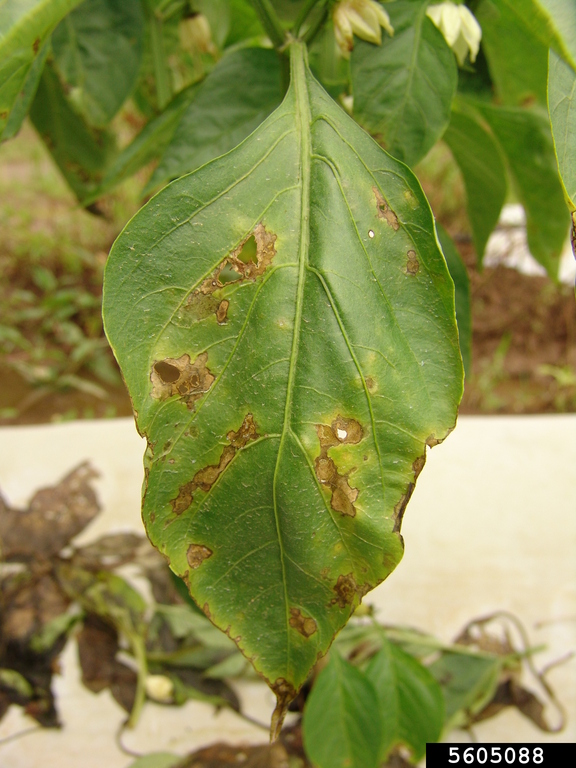
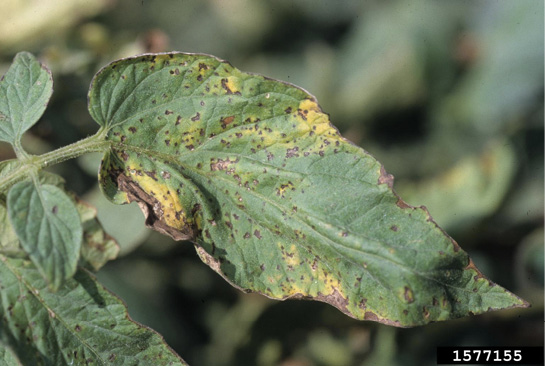
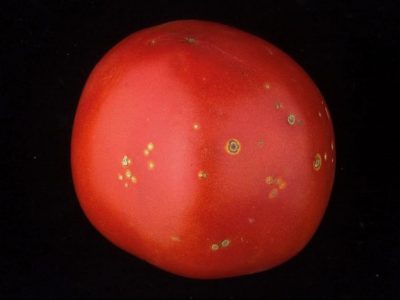
Last 30 Days Have Recorded High Ozone Levels
Similar to June, July and early August have seen ozone level surges reaching toxic levels for crops in Connecticut, with severity varying depending on exact location within the state. Ozone injury in susceptible vegetable varieties develops when ozone levels are over 80 ppb for four or five consecutive hours, or 70 ppb for a day or two when vegetable foliage is at a susceptible stage of growth. Typically, the most susceptible vegetable crops include cucumber, potatoes, watermelon, cantaloupe, snap beans, pumpkins, and squash.
The best recommendation for managing susceptible crops in when ozone levels are high is to whatever extent possible, avoid additional stresses on plants. Do not apply unwarranted pesticides or nutrients during this period. Note which varieties show fewer symptoms and plan to select varieties that are less susceptible in the future.
For more information on the relationship between the Air Quality Index (AQI) and Ozone levels, visit the Air Quality Guide for Ozone and Particle Pollution. For example, ozone concentrations would be 71-85 ppb when AQI is 101-150. To monitor local trends, visit airnow.gov.


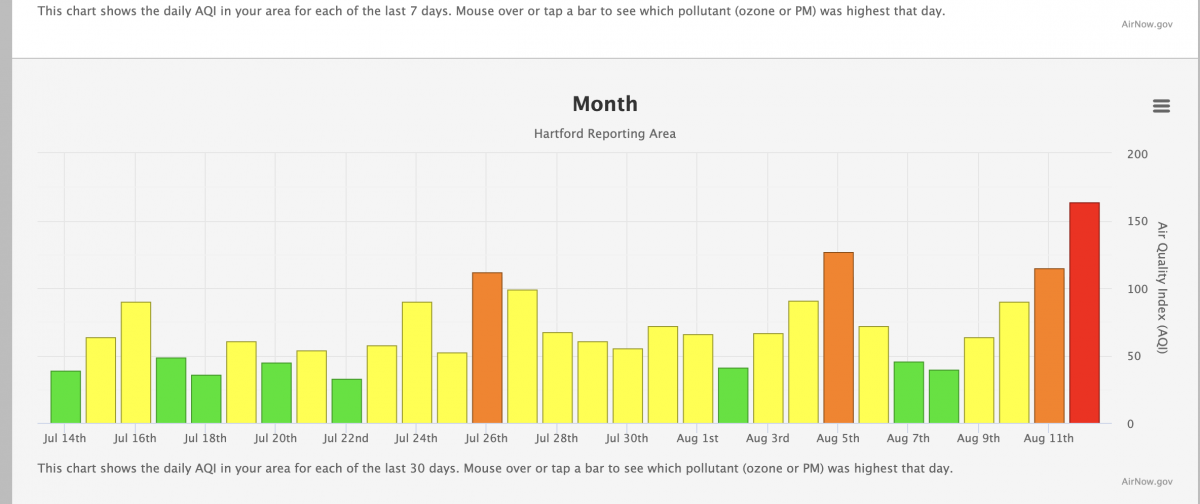
Winter Squash Maturity, Harvest, and Storage
There is a daunting list of diseases, insects, and weather events that threaten the quality of pumpkins and winter squash as we patiently await their maturity. Ideally the plants will stay healthy and the weather will cooperate all the way until the end, but that’s not always the case. Chuck Bornt, Vegetable Specialist at Cornell Cooperative Extension in Eastern New York, highlights what to keep in mind if you have winter squash and pumpkins in your field: Winter Squash and Pumpkin Maturity, Harvesting and Storage Tips.
Sweet Corn Pests - Trap Count Update
| Location | CEW (avg per night) | ECB - NY | ECB - IA | ECB - III | FAW |
| Glastonbury B | .43 | 0 | 1 | 0 | 7 |
View our Sweet Corn Pest ID Guide.
Spray intervals for CEW can be found on our website.
See the New England Vegetable Management Guide for management strategies for all sweet corn insect pests.
Participate in UMN/UNH High Tunnel Cover Crop Trial
Becky Sideman at University of New Hampshire is once again putting the call out to recruit organic high tunnel growers as part of an OREI funded high tunnel cover crops project. This Fall 2025 trial will look similar to last year’s: growers will get sent seed, a free soil test and help interpreting it, and will be asked to complete a couple of short surveys to let the researchers known how it went. A biomass sample from the following spring would be ideal as well, but is not required.
These on-farm trials are meant to evaluate how legume cover crops perform in active farming systems. Farmers will not be asked to plant replicated arrangements of the trial plots on their farms. Instead, researchers will plant all of the cover crop options in replicated plots on a research station, while each participating farmer plants one plot of each of the cover crop options that they select. Farmers can select between two levels of participation and compensation, depending on the amount of time and effort they are willing to commit. Read the full trial instructions, detailed species and timing menu, and farmer expectations for each level here.
Contact the research team at hightunnel-cc@umn.edu with any questions.
Continue to be on the lookout for the following pests...
Want the New England Vegetable Management Guide and/or Northeast Vegetable and Strawberry Pest ID Guide at your fingertips?
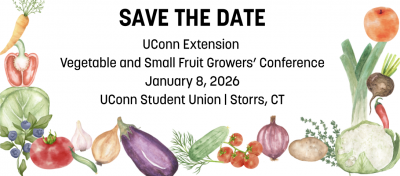
Stay in touch with us
- Share what you see: We're here to assist with identification, management strategies, and guidance on best practices. Send us a photo/message via iMessage at 959-929-1031.
- Facebook Group: UConn Extension moderates a private Facebook group specifically for commercial vegetable producers. It is a space to share photos of insects and diseases you find in your fields, ask questions, share ideas, and stay engaged with growers across the state. Join the "UConn Extension - Vegetable IPM" Facebook Group
- Schedule a consultation: Would you benefit from meeting with an Extension Specialist at your farm to provide insight on pest or disease identification, management strategies, and more? If so, please contact our Vegetable Extension Specialist, Shuresh Ghimire, to setup a farm visit. Contact him at shuresh.ghimire@uconn.edu or 860-870-6933.
Contact Information
Shuresh Ghimire, Vegetable Extension Specialist: shuresh.ghimire@uconn.edu
Nicole Davidow, Vegetable Extension Outreach Assistant: nicole.davidow@uconn.edu
Vegetable IPM Office Phone Number:
860-870-6933
Vegetable IPM Cell Phone Number:
959-929-1031 (feel free to text/iMessage photos)
Vegetable IPM Pest Alert Audio Recording:
860-870-6954
Thank you for reading!
This report was prepared by Nicole Davidow, Outreach Assistant, and Shuresh Ghimire, Commercial Vegetable Specialist, UConn Extension.

The information in this document is for educational purposes only. Any reference to commercial products, trade or brand names is for information only, and no endorsement or approval is intended. Always read the label before using any pesticide. The label is the legal document for product use. Disregard any information in this report if it is in conflict with the label. UConn Extension does not guarantee or warrant the standard of any product referenced or imply approval of the product to the exclusion of others which also may be available. The University of Connecticut, UConn Extension, College of Agriculture, Health and Natural Resources is an equal opportunity program provider.
